M221 Elfquest the Animated Series Sample Production Art Cel
Traditional cel animation is the oldest, and historically, had been the most popular form of blitheness until the advent of digital blitheness. In a traditionally-animated cartoon, each frame is drawn by hand on a celluloid canvass, painted with a brush, and sent to exist photographed onto film stock. Nigh animation today, while still initially being mitt-fatigued on paper, has begun to apply digital post-production blitheness techniques rather than the traditional cel and camera processes of traditional animation. While this digitization does relieve on materials and allows for easier editing, the overall procedure and stringent production schedules remain virtually unchanged. In 1986, when Dragon Ball first began ambulation on Fuji Telly, digital animation did not exist and the majority of the franchise was animated in the traditional mode on celluloid sheets. In recent years the Dragon Ball franchise has entered the digital age, with numerous features, theatrical films, and a new Television set serial all beingness digitally animated using modernistic technology.
It should be noted that although this guide specifically pertains to the animation of episodes, the theatrical films underwent roughly the aforementioned animation process, although films are typically held to much higher quality standards than annihilation produced for a television broadcast. This guide likewise specifically pertains to the blitheness production practices used by Toei Blitheness. Though the animation process is fairly standard throughout the manufacture, each animation studio'south process is slightly unique.
Traditional Cel Blitheness
Traditional animation is a technique in which each frame is fatigued past hand on articulate celluloid sheets and placed over a static groundwork image to create a blended image. This process can be divided up into several basic stages, although this guide will cover those aspects beyond only that of the animation itself. This overview will take a look at the traditional cel animation used by Toei Animation up until 2002 to produce an animated TV series, from its original concept to the final product.
Stage ane: Planning and Scriptwriting
The procedure begins with a planning meeting between the episode's main product staff, which includes the episode's writer, director, and the serial' producers. Together they work out the episode'south master details based on the overall plot of the series set by the series composer and director. During the meeting information technology is established how much of the source material, if any, should be covered in this specific episode or over the grade of numerous episodes. Based on this meeting, the scenario author volition produce a handwritten rough script for the episode, which includes dialogue and very brief direction on what will visually exist occurring.
The serial' main production staff review the rough script and make whatsoever necessary edits, corrections, or adjustments. A rough script will typically undergo three or 4 revisions earlier being finalized and passed on to the episode director. Beyond this bespeak there will be very few, if any, changes to the script.

Series Director Daisuke Nishio Holding a Dragon Ball Z Production Meeting
Prior to beginning the animation phase, a production meeting is held to discuss and strategize an episode's production. The series manager relays the product schedule as set forth by the production supervisor, identifies the available animation staff that will exist used to breathing the episode, and delegates the primary tasks amongst the banana managing director and production progression staff. The appropriate production fabric is also distributed, such as any reference materials, character designs, or scripts. The production staff then begins making the necessary arrangements in order to beginning the actual animation production process.
Stage two: Storyboard
Based on the final script, the episode director creates a storyboard, which is a rough fix of sketches detailing the entire episode — essentially a visual script. The standard practice at Toei Animation is to accept the episode director draw the episode's storyboard themselves, which is often why the storyboard credit is typically not listed on Toei Animation productions. On occasion someone other than the episode director — such as another director, the assistant director, or a talented key animator — volition create the storyboard based on the episode director'southward instructions and a separate storyboard credit is included alongside the episode director credit to denote this modify in the production process. This is typically seen when the episode director is strapped for time or is otherwise a bad artist.
The storyboard divides the episodes upwards into scenes, and then further into the private cuts that comprise the scene. The director determines how many cuts will be needed to create a specific scene, and and then times out each cut to ensure that the episode volition non run over the allotted broadcast time. It is too not uncommon for a storyboard to have no specified scenes and be entirely comprised of cuts. The scenes and cuts are identified numerically in sequential order as they appear on the storyboard, and these identification numbers are carried throughout the entire production process.
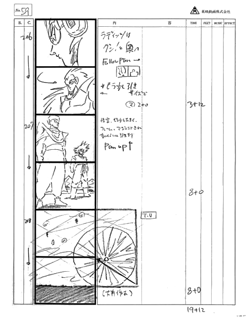
Dragon Ball Z Episode three Storyboard (Hover)
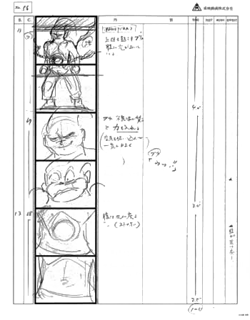
Dragon Ball Z Episode 278 Storyboard (Hover)
Boosted management is besides included on the storyboard beyond that provided in the concluding script explaining what is happening in the scene, such equally the movement of the characters, sound effects, camera instructions, and whatever other of import notes or elements. Some directors will merely provide crude sketches, while others will draw in much greater detail. Overall, the storyboard sketches do non necessarily reflect how the concluding image volition expect, merely are more then used as a template for how the characters volition be positioned, and any other basic elements of a given scene. It is important to note that an episode's storyboard must be finalized before any other work can go along, as the rest of the production process is based on the storyboard.
Phase three: Layouts
With the storyboard completed, the director assigns the storyboard'south cuts to individual key animators. On occasion a specific storyboard sequence will accept been drawn with a detail animator in heed, and this may be the only cut they are assigned, only typically a key animator volition be assigned a sequence of cuts. The majority of the cuts will be assigned based on the talent of the available animators, with some being especially skilled at drawing action scenes, while others may specialize in drawing explosions. Afterward all of the cuts accept been assigned, the director holds an blitheness meeting to provide some guidance to the key animators on how they envision things should await and to answer any questions they may have about the storyboard. To avoid any complications farther in the process, it is crucial that the animators sympathize the story and the managing director's vision prior to any actual animation being produced.
The cardinal animators and so create layouts, or more detailed versions of the image for that cut in the storyboard, for each of their assigned cuts. In contrast to the storyboard, layouts are fatigued accurately as to how the terminal product should look. The layout will serve as a blueprint for the following stages of animation, mapping out how the characters and scenery should exist framed, besides as depicting the verbal details of how the characters are to be positioned.
Phase 4: Revisions
Later on the episode managing director reviews the layouts for inconsistencies and content, they are sent to the animation supervisor to review the artistic attributes. The animation supervisor is responsible for overseeing all aspects of key animation, including the layouts. If a layout is too poorly drawn, or strays from the graphic symbol design, the blitheness supervisor will revise it with the appropriate corrections. When the layouts take been approved by both the episode director and blitheness supervisor, they are photocopied and the originals are sent to the fine art section to begin work on the background art.
Phase five: Key Blitheness
With their layouts approved, the fundamental animators begin drawing the episode'south key frames, which is arguably the most important stage in the animation process, as these are the frames that will ultimately create each scene. The primal artwork is highly detailed and indicative of how the eventual animation cel should look, complete with details on coloring, shadows, highlights, move (if it applies), and any other necessary info needed for creating the concluding product. While there are many people that have a hand in creating the final version of every cut of animation, information technology is the key animator who creates the personality of that cutting. The key animator is responsible for drawing and timing the most of import frames of a detail shot, which ascertain the main sequences of movement. Visual examples of this can be seen beneath in blithe versions of the key frames of Super Saiyan Goku's boxing with Freeza and Vegeta's sacrifice against Majin Boo.
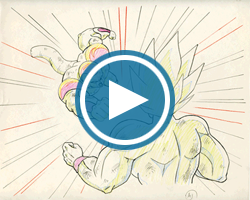
Dragon Ball Z Episode 103 Key Animation
by Yōko Iizuka (Blithe GIF past Zanzoken)
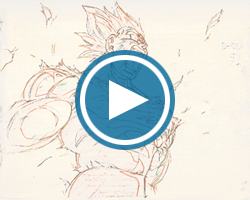
Dragon Ball Z Episode 237 Key Animation
by Toshiyuki Kan'no (Animated GIF by Ajay)
The key animator volition besides provide all of the timing for the key and in-between frames in a cutting, creating a timing sheet for the in-betwixt animators to reference (additional information on this below). In some scenes there will be multiple moving elements, such equally main characters, background characters, vehicles, smoke, falling rocks, etc. The key animator must identify these elements and plan out the entire scene in accelerate to determine how many cels will be required to breathing these elements. This is accomplished by layering the cels, with each layer being identified. In the example below the frame is identified equally "A2", meaning information technology is the 2nd frame in the "A" layer of this specific shot. Information technology likewise includes a timing chart for the motility of Cell's easily. The timing chart indicates how many in-between frames volition exist needed to get from central frame A1 to A2 — in this case viii (8) frames — and the timing of these in-betwixt frames in relation to the key frames.

With so many different animators working on a single episode, each with their ain creative styles and skills, it is the job of the animation supervisor to oversee and correct the fundamental animation, essentially shaping the overall look of the episode. If a gear up of frames diverge likewise far from the episode's overall manner or the character designs, the animation supervisor volition revise them and add cosmetic notes. Since all other frames and coloring will exist based on these completed key frames, these elements will naturally take on the await of how the animation supervisor corrected the cardinal frames. The key animator will then make these corrections to their frames and re-submit them for review. In one case all of the frames from a cutting or scene have been approved by the animation supervisor, they are sent to the primary animator for concluding review.
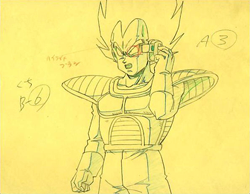
Dragon Ball Z Episode 044 Primal Art Revision
by Katsuyoshi Nakatsuru (Hover)
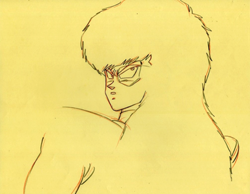
Dragon Ball Z Episode 072 Key Art Revision
by Masayuki Uchiyama (Hover)
On occasion the animation supervisor will step in to provide a few shots that are either difficult to draw, or to assist meet the production deadline, merely there are also some animation supervisors that will provide key fine art for nearly an entire episode. At that place are also times where a key animator's frames may stray from the overall await of the episode, but are so well fatigued that the animation supervisor will not correct them. Across this betoken, the animation supervisor has no other roles, as he is only in accuse of key animation. After this stage, the chief animator is in charge of checking and overseeing the residual of the animation process.
Stage 6: In-Between Blitheness
After the key animation drawings accept been checked and approved, they are sent to the in-betwixt animation artists to begin cartoon the frames missing in-between the cardinal animation frames. This is washed based on the timing sheet created by the primal animator, which indicates how many in-betwixt frames will be needed to become from one key frame to the next. In some instances when an element in the animation is not linear, such as the move of an arm, tail, or head, the cardinal animator will include a timing chart to indicate the timing and placement of that element's move in-between the primal frames. The in-between animator is also responsible for cleaning up the lines of the key frames and preparing the drawings to exist passed on to the next department, the finishing department.
Unlike key animation, in-between blitheness does not provide much elbowroom for personal expression. The in-between artist volition depict the missing frames as instructed by the cardinal animator, and nothing more. However, in-between frames practice require considerable skill in their ain right. Poorly drawn in-between blitheness can ruin a shot of perfectly practiced key animation, while good in-betwixt blitheness can considerably improve mediocre key animation. Traditionally, animators in Japan will become through a period of apprenticeship as in-between animators earlier ascending to key animator.
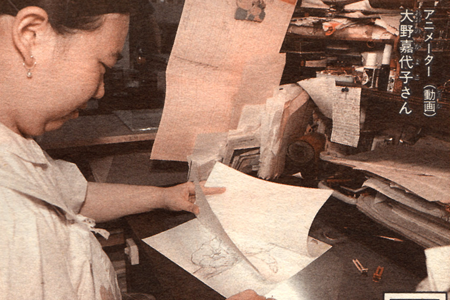
Kayoko Ōno Drawing In-Between Frames
Completed in-between animation is then inspected past the chief animator, or in-between checker, to brand certain that there are no gaps or bad-mannered movements. If there are no problems during animation testing, and so the in-between animator will update the timing canvass with the final cel numbering (detailed in Stage 8). At this bespeak, the overall artwork portion of animation production is over, as none of it will receive any boosted revisions or corrections. In total, an average animated Boob tube episode of the time was comprised of roughly 3,000 to v,000 private drawings.
Stage seven: Finishing Touches, Special Effects, and Backgrounds
The completed animation is and so sent to the finishing department, where a replica of each cartoon is painted onto a clear celluloid (cel) sheet by a finishing touches artist. Using a backlit animation desk, a blank cel is placed over top of the artwork and the black outlining is traced onto the cel. This tracing was done past hand for Dragon Brawl and Dragon Ball Z, only was later on accomplished in Dragon Ball GT using Xerography technology, a dry photocopying technique.
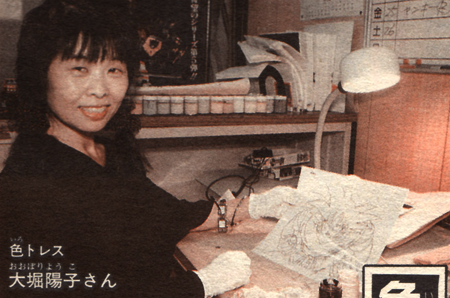
Yōko Ōbori Tracing In-Betwixt Frames Onto Cels
Once the outline ink dries, color paint is applied to the opposite side of the cel based on the color palette established past the colour coordinator and episode director, or every bit specifically called out by the key animator. Below is a completed cel, from the original cardinal artwork to finished paint, of Mister Satan drawn by Studio Cockpit for Dragon Ball Z episode 174.
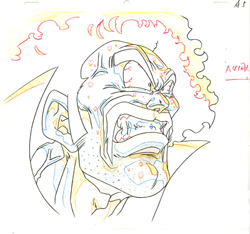
Original Key Artwork on Paper
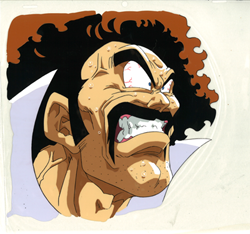
Traced, Inked, and Painted Celluloid Sail
While the animation cels are being produced, special furnishings artists begin creating specialized cels to finish off each scene with additional detail and effects, such equally shadow, fire, fume, or in the example of Dragon Brawl, energy and ki techniques. The techniques used to create such effects include drybrushing, airbrushing, charcoal, grease pencils, backlit animation or, during shooting, the lensman can use multiple exposures with various diffusing screens, filters, or gels.
While the animation is being completed, scene backgrounds are painted past artists who specialize in a way more reminiscent of traditional canvas painting. Dissimilar painting cels, painting background art is commonly a very long and difficult process, due to the creative qualities and details of each background. The groundwork fine art, which is created based on the layouts submitted by the key animators, is overseen by the art director. The art manager, who is frequently involved with an episode's production from the storyboard and layout stages, will create rough sketches or art boards of the backgrounds before delegating them to dissimilar groundwork artists.
Stage 8: Photography and Initial Editing
When a cutting of blitheness is completed, its cels and all of their corresponding reference materials are packaged together and sent to the photographer. Each scene is accompanied by a timing sheet, as updated past the in-between animator, which lists all of the animation cels that make up the specific cut and instructs the photographer how to photograph each shot. Each line on the timing canvas represents a unmarried frame. With the film being played at a frame rate of 24 frames per 2d (fps), it takes 24 frames/photographs to create a unmarried second of blithe footage. The instance time sheet below, which lists three central frames and four in-between frames, represents only i second of footage.
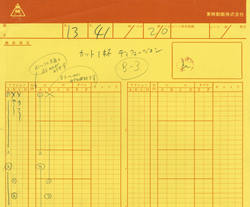
Dragon Ball GT Tv Special Fourth dimension Sheet
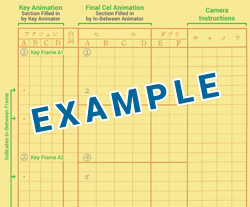
Example Blitheness Time Canvas (Click)
Framing the cel is very important, since if information technology is non framed correctly several problems may arise, including parts of the paradigm being on the screen that are not intended to be seen, such as the border of the cel paint (rare, merely information technology has been known to happen). A more common trouble is "jitter"; if one frame happens to exist photographed too loftier up in contrast to the final frame photographed, the end result will be that the frame appears to jump as the animation is running. Although traditional cel animation more often than not has a much richer and deeper await than about digital animation, its i true downfall is occasional poor photography, which results in shaking animation.
Based on the cut's timing sheet, the photographer's assistant will mitt the appropriate cels needed for a specific frame to the photographer, who so places them over the static groundwork art on the camera stand up and frames the shot according to the primal animator'south original layout sketch. Special attention must exist paid to shots that are comprised of multiple cels, as the cels must be layered on height of one another in the proper order. The cels are always placed in alphabetical order, such that the "A" layer cels will always be placed first, direct over the groundwork fine art, with the "B" layers beingness placed on top of the "A" layers, and and then on. A piece of glass is lowered onto the cels in order to flatten whatsoever irregularities, and the composite epitome is then photographed by a special animation photographic camera. This process is repeated until the unabridged cutting has been photographed onto a roll of 16mm film, which is then labeled and sent to Toei Chemistry for development.
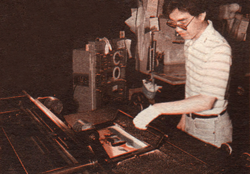
Tetsuo Ōfuji Photographing Cels
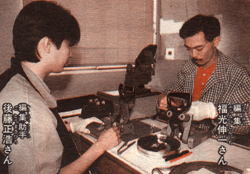
Shin'ichi Fukumitsu Editing Film
Afterwards the 16mm film negative is developed, information technology is sent to the editor for processing. Since each cut of blitheness is photographed as it is completed, many cuts are received out of order and on different rolls of film. Information technology is the editor'due south task to sort through all of the footage, placing each cutting in the proper order equally originally identified on the episode's storyboard. Afterwards inspecting the film for any misaligned shots, discrepancies, or imperfections, the editor then splices and joins these photographed sequences of 16mm film together into a single film reel, creating the episode'due south "film principal". It should be noted that the film editor is dissimilar traditional editors in Western film making and accept no real creative control, equally no boosted footage beyond what is chosen for in the episode's storyboard is created.
Phase 9: Dialogue, Sound Effects, and Musical Score
Toei Animation uses a vocalisation-over process known equally "After Recording" (アフレコ), pregnant that the dialogue is recorded after the animation is completed, or in some cases when pressed for time considering the animation is behind schedule, while it is actually still in product. The later recording procedure allows for faster animation product, as the animators practise not have to match their drawings to the dialogue, and allows for the cast to maintain a more natural period of their performances. This is in contrast to "Prerecording" (プリレコ), the process commonly used in the United states, where the dialogue is recorded prior to the blitheness's production. Also in contrast to Western practices, the dialogue is recorded all at once by the entire cast in a big studio, as opposed to individually in small recording booths.
As the voice actors arrive at the recording studio, they are given a re-create of the last production script, which is typed up and bound into a booklet. The concluding script also now includes detailed descriptions of the episode's visual content, in improver to the episode's dialogue, to help the voice actors follow along. The series director and producer(due south) are besides in the studio booth during the recording to provide additional direction to the cast. Aslope them are the studio's recording director and their banana, who operate all of the recording equipment. For reference, the dialogue for all of the franchise's episodes and films up thru the 1990s were recorded at the Toei Audio Visual Fine art Centre (TAVAC).
Prior to recording whatsoever actual dialogue, the cast sits downwardly in the studio and performs a test reading of the script while the episode's animation is played from a projector. With a better grasp of the episode's content, the bandage perform a examination recording. Since the dialogue is recorded all in i accept past the entire cast, including whatever narration or background dialogue, it is often non possible for each member of the bandage to take their own private microphone, and instead the studio is typically set up with iii to four microphones in the heart of the room. Because of this mode of recording, the test recording helps the actors effigy out when to come up to the microphone to perform their line(s). When the director is satisfied with the performances, and all of the recording logistics have been worked out, the episode's dialogue is finally recorded. The recording of a single episode's dialogue generally takes betwixt two to three hours, with the inclusion of a brusk break in the middle and whatsoever retakes at the end.
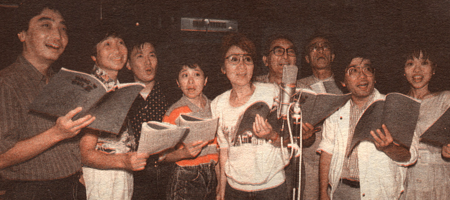
The Bandage of Dragon Brawl Z Recording an Episode at TAVAC
Following the dialogue recording, the music selector and sound effects artist individually meet with the recording director to lookout the episode's film and determine the background music and sound effects, respectively. Any new musical tracks or sound effects are recorded prior to this meeting, typically based on the episode's script and the scene timing established by the storyboard. Once the placement for each musical rails and sound effect has been determined, as based on the animation timecode, the recording director creates a multi-track tape with the appropriate selections. After all of the audio recording is completed, the recording managing director sits downwards in the recording studio with the sound director and mixes all of the sound and voice tracks together while watching the episode. Once everything is mixed to both of their satisfaction, the recording director combines all of the individual tracks into a single 16mm "cine record".
Stage 10: The Final Product (Masters)
While the 16mm film principal and cine tape serve equally the original archival prints, they are not actually the final products used for its broadcast or domicile video distribution. A copy of the 16mm movie master is created, which is re-framed and slightly zoomed in to capture a smaller amount of image. By re-framing the moving picture once once again, the likelihood of unwanted portions of the cel beingness seen in the footage is greatly reduced.

The original 16mm film master is then placed into protective storage, and the new picture show serves as the "first generation" primary copy, with any additional prints made from this new film. Different the original film master (video) and cine record (audio), which are separate reels of flick, the "commencement generation" master copy combines both the video and audio components onto a singe 16mm film reel. A copy of the cine tape audio is placed forth the length of the motion-picture show using an analog strip of variable expanse optical soundtrack, whereby the sound accompanying the footage is physically recorded onto the picture show (as seen beneath).
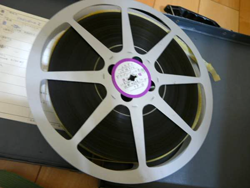
Dragon Brawl Z Broadcast Film Reel
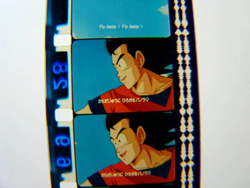
16mm Pic With Optical Soundtrack
For television broadcast, a "second generation" copy of the master re-create is sent to the broadcaster. Upward until the end of the 1970s, the majority of TV stations would broadcast shows using the picture show'south optical soundtrack due to its ease of storage. However, by the 1980s many Goggle box stations had begun muting the film's optical soundtrack in favor of broadcasting higher quality audio from a re-create of the original cine record. In order to avert having to shop the original cinematics tape, Toei Animation would often send it to Fuji TV for broadcast and merely retain the master re-create's optical soundtrack equally their internal audio source. Unfortunately, the original cine tapes were typically disposed of by the TV station post-obit an episode's initial circulate, equally they were quite large and the station's storage space was at a premium.
Modern Digital Animation
Toei Animation first began using digital blitheness techniques in 1998, and past 2000 the majority of their titles were beingness fully produced digitally. In 2002, Toei Blitheness ceased the use of traditional cel animation practices and its animation production became fully digital. This transition was largely driven by the reduced product costs and the allowance for a shorter product schedule. The price reduction comes not but from the reduction in production fourth dimension, but too from the reduction of consumable materials such every bit cels, acrylic paint, and film, equally they get unnecessary due to the digitization of the production process. Information technology also allows the production process to exist more than efficiently carried out over a digital network system, eliminating the need to transport and evangelize concrete materials between studios or Goggle box stations, reducing degradation and generational loss of the last production, and reducing the overall physical storage space required.
According to Toei Blitheness'southward official website:
Animation Production From Across the Ocean
Our studio in Japan is not the only identify where our animation is produced. TOEI Animation PHILS., INC. (TAP) is our subsidiary in Manila, Philippines, with which our Ōizumi Studio in Tokyo shares a borderless production network connected with optical cables. Nosotros also take dedicated lines connecting to the 21 domestic production studios that piece of work with u.s., and our entire production process is digitalized for maximum efficiency.
Information technology should be noted that at Toei Animation the shift toward digital production practices more often than not afflicted its post-product piece of work, such equally the painting and filming of drawings, equally opposed to the actual animation itself. The term "digital animation", as it applies to Toei Animation's mod production practices, does not imply the animation drawings are entirely created digitally, just rather that the final animated production is available in a digital format. Aside from specific computer-generated graphics and special effects elements, the bulk of artwork created for mod Dragon Brawl productions is still hand drawn by individual artists, either on paper or digitally with a tablet.
Stages i-v: Planning to Key/CG Animation
Although many of the post production processes are performed digitally, the majority of the planning stages remain near identical to the traditional animation process. Based on the final script, the episode director draws a storyboard of crude sketches detailing the entire episode. After an episode'southward script and storyboard have been established, cuts are delegated betwixt the key animation artists to create their respective layouts.
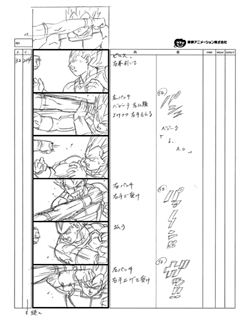
"Dragon Brawl Z: Battle of Gods" Storyboard
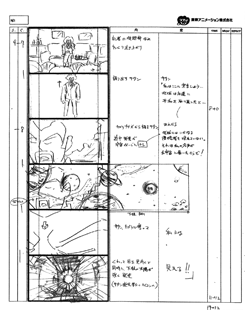
Dragon Ball Super Episode 1 Storyboard
One time the layouts have been approved by the episode director, they are digitally scanned and saved on Toei Animation's network. Also during this stage, any scenes or items requiring 2nd or 3D digital animation are identified and sent to the digital artists for processing. While the 3D blitheness is created using a combination of diverse estimator graphics software and script packages, Toei Blitheness largely utilizes Autodesk Maya. Other digital 2d furnishings, such equally textures or the move of burn down and h2o, are also created by the digital artists.

Digital Artist Drawing the Dragon Balls
With the layouts complete, the key animators begin cartoon the episode's key frames. While all of the animation following these initial stages are drawn digitally using a tablet, the storyboard and key frames are still traditionally mitt drawn with pencil on sheets of paper. There are some animators that have begun digitally drawing their key art, simply so far none have worked, or are currently working, on Dragon Ball productions.
After the key blitheness drawings have been completed, they are digitally scanned into RETAS! PRO, a 2nd blitheness software suite adult past CELSYS. The software then vector traces the scanned drawings, separating each key frame into its individual lines, as though it had originally been digitally drawn, and isolating the drawing'southward shadow markup as a separate layer. Since the drawings are stored in vector data formats, they are resolution independent and exercise not lose detail or quality when zoomed in or reduced in size. While traditional analog key animation is the standard do for Toei Animation, some contracted blitheness studios prefer to only produce digital primal animation drawings, negating the need to scan and trace them.
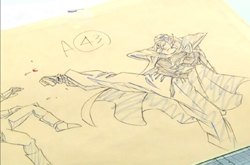
"Dragon Ball Z: Revival of 'F'" Key Art
past Tadayoshi Yamamuro
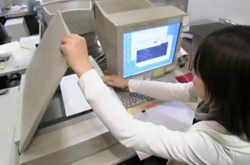
Digitally Scanning Fundamental Fine art Into RETAS! PRO
The key animation is so checked by the animation supervisor, who can now precisely correct individual frames as needed by creating a correction layer over the original key frame within the software. Once the key frames have been approved, the key animator creates a timing sheet for the entire cut, which indicates how many in-between frames will be needed to go from one key frame to the side by side. The software then generates a linear animation timeline, inserting the appropriate number of blank frames in-betwixt the primal frames as indicated past the timing sheet.
Stage 6: In-Between Blitheness and Digital Coloring
Later on the animation timeline has been established, the in-betwixt animation artists begin digitally drawing the frames missing in-between the key animation frames. The software features a light table function which allows the animator to view subsequent frames on height of each other transparently, letting them easily reference the adjacent frames equally they draw a missing frame. The animator can also run a rough animation test to check the motion depicted between frames, ensuring that nothing jarring stands out. This is very similar to the traditional animation check in which the animator held the paper drawings upward and quickly flipped through them, simulating the animation. Even so, every bit the digital images can be transparently placed over one another, the software is much more than useful in catching such errors or mistakes.
Completed in-between animation is then again inspected by the chief animator, or in-betwixt checker, to make sure that at that place are no gaps or awkward movements. If there are no bug during final blitheness testing, so the overall artwork portion of animation production is over and the in-betwixt animator will update the timing sheet with the final numbering. In total, the boilerplate modern animated TV episode is comprised of roughly 3,000 to 4,000 individual drawings (including both cardinal and in-between frames).
While in the past the completed animation was sent to the finishing department to be traced onto clear celluloid (cel) sheets, this step is no longer necessary in the modern animation procedure as the concluding digital drawings have already been created during the in-between blitheness stage. Therefore, in one case the in-between animation is completed, it tin can immediately exist colored. Traditionally, the cel painting was too performed past the finishing department, but in an effort to more than efficiently streamline this task, information technology is now typically completed by the in-between animation studio itself. Using the RETAS! PRO software, Toei Animation and other studios tin at present digitally color 150 drawings in the fourth dimension information technology had traditionally taken them to hand paint 50 cels.
Phase 7: Backgrounds
While the blitheness is existence completed, scene backgrounds are painted by artists who specialize in a style more reminiscent of traditional canvas painting. The background fine art, which is created based on the layouts submitted by the fundamental animators, is overseen by the art managing director. Similar to the cardinal blitheness drawings, the background art is still painted past hand on physical media and then digitally scanned into the blitheness software at high resolutions. The backgrounds are then digitally touched upward, removing any imperfections and adjusting color tones as desired. On average, a modernistic animated TV episode is comprised of approximately 300 backgrounds.
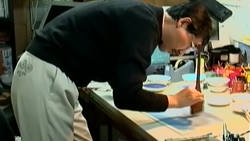
Ryūji Yoshi'ike Painting Background Art
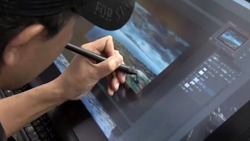
Digitally Touching Up Groundwork Art
Stage 8: Special Effects, Photography, and Editing
Once the drawing has been colored, it is saved and sent to the special furnishings artist to add additional particular and effects, such as shadows, lord's day glare, fire, smoke, or in the case of Dragon Brawl, energy and ki techniques. These effects are drawn past hand with a stylus pen and tablet, and are meant to add additional detail to the animation to provide a sense of realism to a 2D blithe object. The completed cuts are then sent on to the photographers to be composited.
While the act of shooting a cut's composite animation is however referred to as "photography" in modern animation, the term'due south apply is a mere carryover from traditional animation, as in modern animation there is no concrete camera or film involved. Every bit done traditionally, the photographer places a cutting'due south drawings over the appropriate background based on the timing sheet provided and and so captures the composite images of the cut. In modern terms, this is known as rendering. However, in modern blitheness the photography procedure is much more involved due to the fact that the software allows the composition of a given scene to be much more complex: background art tin can be panned, zoomed, or placed diagonally, drawings can be assigned specific paths or coordinates, and the camera-work inside a cut can get quite complicated with varying acceleration, move path, or orientation functions. The software also allows the photographer to create 3D spaces using second drawings and backgrounds. With compositing complete, the cut tin then be exported to the appropriate file format, depending on its intended use. While the cutting's completed animation can be exported to diverse movie file formats, private frames tin can also be exported every bit raster images (PNG, JPG, etc.) for use in advertising, publications, or website blueprint.
For editing, the cut's completed blitheness is exported as both a full and lower resolution file. The series editor and then begins creating a rough cut of the episode using the lower resolution video, which contains far less information and is therefore easier to load and edit than the full resolution video, and places the cuts together in the correct society of events. This stage of editing is referred to equally offline editing, which is carried out using non-linear editing software. Once the offline edit is complete and approved past the director, it is sent to Toei Digital Lab for terminal online editing and mastering. A copy of the edited video footage is also sent to the recording studio to be used during vocalization recording sessions.
Stage 9: Dialogue, Audio Effects, and Musical Score
Although recording technology has changed, the actual recording process between traditional and digital blitheness has remained most identical, utilizing the "Later on Recording" process. With the final production script in hand, the voice actors do a test reading of the script while the episode'south animation is played on large loftier-definition televisions or digital projectors, as opposed to the analog film projectors used during film-based recordings, which are controlled from the recording booth. Following the test reading, the voice actors perform a test recording and work out all of the recording logistics. When the director is satisfied with the performances, the episode's dialogue is finally recorded and saved in a digital format.
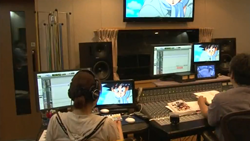
Mitsuharu Itō (Right) in the Recording Booth
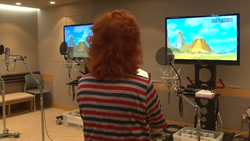
Masako Nozawa Recording Dialogue
Up until 2013, all of the franchise's dialogue had been recorded at the Toei Audio Visual Art Centre (TAVAC) studio. In September 2015 the TAVAC studio was closed due to structural integrity concerns, and all recording sessions have since been moved to the Sound Inn studio or Toei Digital Center. While the recording studio has changed, all of the audio production aspects are even so overseen by TAVAC.
While the episode is still in the early stages of production, the episode director, audio director, and producers determine any new musical tracks and sound effects that need to be recorded based on the episode'due south script and the scene timing established by the storyboard. With the dialogue and musical recordings completed, the episode and sound directors encounter with the recording managing director and mixes all of the voice and musical tracks together while watching the episode. Once everything is mixed to all of their satisfaction, the recording director saves the file and sends it off for final online editing.
Phase ten: The Final Production (Masters)
With all of the episode's individual components complete, the Toei Digital Lab housed at the Toei Digital Center begins the online editing process. The full "online" resolution video and mixed audio information files are kickoff imported into advanced linear authoring software and so properly lined up. In one case the episode portion is prepare, the opening blitheness, title bill of fare, eyecatches, catastrophe animation, and side by side episode preview are inserted. The online editor so begins formatting the episode, adding any additional logos required for the broadcast version, the finalized episode title to the championship carte du jour, the finalized next episode title to the next episode preview, and finally the episode credits to the opening and ending animations. The whole process is typically overseen by the episode managing director, or their assistant, and diverse series producers.

Professional Online Editing Room
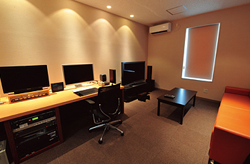
Digital Circulate Editing Room
With the formatting consummate, each individual version of the episode is exported into the desired digital video format with the proper encoding properties. The encoded video files are then distributed to the appropriate parties, such as the broadcast versions of an episode being sent to each regional Fuji TV chapter station, and the original files are then sent dorsum to Toei Animation to exist backed up on their servers for archival purposes. At some point, following any animation edits, Toei Blitheness sends digital master copies of each episode to Happinet, the visitor responsible for creating and distributing the series to the abode video market on DVD and Blu-ray.
Source: https://www.kanzenshuu.com/animation-production/process/
Post a Comment for "M221 Elfquest the Animated Series Sample Production Art Cel"